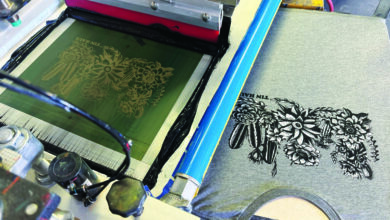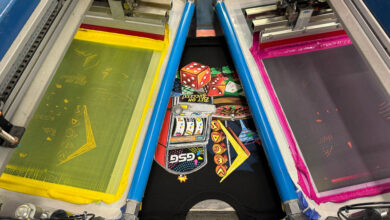Heat is one of the biggest challenges we face as printers. It really surprises me how little some printers pay attention to heat in their process. It throws some curveballs at printers, and we need to pay attention and use every tool possible to measure and limit its effects on our final product.
Today’s printers are faced with a larger variety of garments and inks than ever before. Not considering how heat affects our products is just asking for trouble. How can you be sure you’re using the correct heat settings to ensure quality curing and avoid pitfalls like under curing, scorching, and dye migration?
1. Check temps on every job
The “set it and forget it” approach to dryer temps is a recipe for disaster these days. Different garments absorb heat at different rates, and it’s important to know what’s going through the dryer before you start a run. It is also important to understand that the temp on the dryer does not reflect the temp of the ink on the shirt. Just because your dryer reads 320 degrees F does not mean the ink temperature is hitting the proper curing temp.
Checking the ink temperature on every job is something I always preach. It may seem time-consuming and redundant to do this on every job, but in the long run, it’s worth it for peace of mind. While no printer wants to deal with scorching and dye migration problems, the issue of under curing is nightmarish. I’d be willing to bet most of you have gotten the dreaded phone call from a customer explaining that the ink has “washed out” of the garment. Fixing one order isn’t the end of the world but what will keep you up at night is worrying if other customers might call with the same issues. If this is something that has gone unnoticed for a while, you could be staring at thousands of dollars in reprints and lost revenue. Do yourself a favor and get some heat test strips, a heat gun, or a donut probe and make checking ink temps a standard part of your process.
2. Use the right ink for the garment
Cotton, polyester, rayon, spandex, bamboo, Lycra-the list goes on. Today, there are a larger variety of materials used in creating the garments we print on than ever before. As printers, we need to make sure we have the proper inks to tackle these challenges. It’s not enough to think in a “one ink fits all” mindset anymore. Becoming diversified in different inks and how these products work with various materials will give you a leg up on the competition and build confidence when speaking to customers that request unique garments. Read tech sheets from ink manufacturers and do some testing. The info is out there to conquer these new challenges and educating yourself before running a job goes a long way in cutting out stress involved with trying new techniques.
—T&J Printing Supply



